Blog & Latest Updates
Fly Fishing Articles
Insects by Common Name


Mayfly Species Rhithrogena hageni (Western Black Quill)
Taxonomic Navigation -?-
Kingdom
Animalia (Animals)
» Phylum
Arthropoda (Arthropods)
» Class
Insecta (Insects)
» Order
Ephemeroptera (Mayflies)
» Genus
Rhithrogena
» Species hageni (Western Black Quill)
Common Names
Where & When
Region: West
Time Of Year (?): July to August
Preferred Waters: Large rivers and streams
Altitude: Above 5,000 feet
There are conflicting accounts of the hatch dates for this species. Caucci and Nastasi list it as a July-August emerger, but Knopp and Cormier speak of it hatching in the spring.Time Of Year (?): July to August
Preferred Waters: Large rivers and streams
Altitude: Above 5,000 feet
Hatching Behavior
The nymphs emerge on the bottom of the river and float to the surface as fully formed duns.
Spinner Behavior
Time Of Day: Late evening to dusk
The spinner falls are more important than the emergence. Knopp and Cormier give an unusually specific description of the conditions for a spinner fall in Mayflies: An Angler's Study of Trout Water Ephemeroptera :Female spinners commence their fall during the evening or just before dusk, when air temperature has fallen to the low 60s °F. If the air temperature drops below 58°F, the spinner fall is often delayed until the next morning.
Pictures of 4 Mayfly Specimens in the Species Rhithrogena hageni:
Male Rhithrogena hageni (Western Black Quill) Mayfly Spinner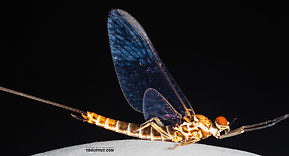 View 14 PicturesAlthough I could not find the preserved specimen to examine under my good new microscope, I'm tentatively calling it one Rhithrogena hageni, based on apparent similarity to this specimen, which I was able to positively ID.
View 14 PicturesAlthough I could not find the preserved specimen to examine under my good new microscope, I'm tentatively calling it one Rhithrogena hageni, based on apparent similarity to this specimen, which I was able to positively ID.
The relative angle of the penes (Penes: The paired genital structures of most male insects, which vary widely in form and are one of the main characteristics used for species identification.) is a bit shallower in this specimen, but I photographed another specimen from the same collecting trip (and I think even the same swarm, although I don't recall for sure) as the other one, and it had the shallower angle seen on this specimen. I'm guessing it's just variation within the species.
 View 14 PicturesAlthough I could not find the preserved specimen to examine under my good new microscope, I'm tentatively calling it one Rhithrogena hageni, based on apparent similarity to this specimen, which I was able to positively ID.
View 14 PicturesAlthough I could not find the preserved specimen to examine under my good new microscope, I'm tentatively calling it one Rhithrogena hageni, based on apparent similarity to this specimen, which I was able to positively ID. The relative angle of the penes (Penes: The paired genital structures of most male insects, which vary widely in form and are one of the main characteristics used for species identification.) is a bit shallower in this specimen, but I photographed another specimen from the same collecting trip (and I think even the same swarm, although I don't recall for sure) as the other one, and it had the shallower angle seen on this specimen. I'm guessing it's just variation within the species.
Collected July 8, 2019 from the Ruby River in Montana
Added to Troutnut.com by Troutnut on July 18, 2019
Added to Troutnut.com by Troutnut on July 18, 2019
Male Rhithrogena hageni (Western Black Quill) Mayfly Spinner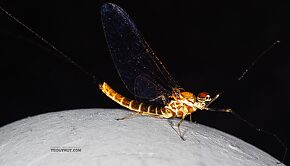 View 15 PicturesI collected this spinner from the trail (old logging road) above a whitewater canyon on a small stream in the Cascades. I'm fairly positive on the ID: in Traver 1935 it keys out to Rhithrogena doddsi, which is now a synonym (Synonym: A former name of a taxon, usually a species. Entomologists frequently discover that two insects originally described as different species are one in the same, and they drop one of the names. The dropped name is said to be a synonym of the remaining name. These changes take a while to trickle into the common knowledge of anglers; for example, Baetis vagans is now a synonym of Baetis tricaudatus.) of Rhithrogena hageni. The penes (Penes: The paired genital structures of most male insects, which vary widely in form and are one of the main characteristics used for species identification.) differ slightly from the drawing in that book, but they're a very close match to drawing from the original hageni description in Eaton 1885.
View 15 PicturesI collected this spinner from the trail (old logging road) above a whitewater canyon on a small stream in the Cascades. I'm fairly positive on the ID: in Traver 1935 it keys out to Rhithrogena doddsi, which is now a synonym (Synonym: A former name of a taxon, usually a species. Entomologists frequently discover that two insects originally described as different species are one in the same, and they drop one of the names. The dropped name is said to be a synonym of the remaining name. These changes take a while to trickle into the common knowledge of anglers; for example, Baetis vagans is now a synonym of Baetis tricaudatus.) of Rhithrogena hageni. The penes (Penes: The paired genital structures of most male insects, which vary widely in form and are one of the main characteristics used for species identification.) differ slightly from the drawing in that book, but they're a very close match to drawing from the original hageni description in Eaton 1885.
I'm using its ID to put a species ID on a female dun and mature nymph collected on the same trip. I'm also using this one's ID for a specimen with seemingly identical reproductive anatomy from Montana.
Lastly, I have included here a couple pictures of the genitalia of a different specimen collected on the same evening, from the same river, and I think even the same swarm (although I don't recall that 100 %). They're angled a bit differently, and I couldn't locate the mid-ventral (Ventral: Toward or on the bottom.) spines, but I'm guessing I'm just seeing intra-species variation.
 View 15 PicturesI collected this spinner from the trail (old logging road) above a whitewater canyon on a small stream in the Cascades. I'm fairly positive on the ID: in Traver 1935 it keys out to Rhithrogena doddsi, which is now a synonym (Synonym: A former name of a taxon, usually a species. Entomologists frequently discover that two insects originally described as different species are one in the same, and they drop one of the names. The dropped name is said to be a synonym of the remaining name. These changes take a while to trickle into the common knowledge of anglers; for example, Baetis vagans is now a synonym of Baetis tricaudatus.) of Rhithrogena hageni. The penes (Penes: The paired genital structures of most male insects, which vary widely in form and are one of the main characteristics used for species identification.) differ slightly from the drawing in that book, but they're a very close match to drawing from the original hageni description in Eaton 1885.
View 15 PicturesI collected this spinner from the trail (old logging road) above a whitewater canyon on a small stream in the Cascades. I'm fairly positive on the ID: in Traver 1935 it keys out to Rhithrogena doddsi, which is now a synonym (Synonym: A former name of a taxon, usually a species. Entomologists frequently discover that two insects originally described as different species are one in the same, and they drop one of the names. The dropped name is said to be a synonym of the remaining name. These changes take a while to trickle into the common knowledge of anglers; for example, Baetis vagans is now a synonym of Baetis tricaudatus.) of Rhithrogena hageni. The penes (Penes: The paired genital structures of most male insects, which vary widely in form and are one of the main characteristics used for species identification.) differ slightly from the drawing in that book, but they're a very close match to drawing from the original hageni description in Eaton 1885.I'm using its ID to put a species ID on a female dun and mature nymph collected on the same trip. I'm also using this one's ID for a specimen with seemingly identical reproductive anatomy from Montana.
Lastly, I have included here a couple pictures of the genitalia of a different specimen collected on the same evening, from the same river, and I think even the same swarm (although I don't recall that 100 %). They're angled a bit differently, and I couldn't locate the mid-ventral (Ventral: Toward or on the bottom.) spines, but I'm guessing I'm just seeing intra-species variation.
Collected July 4, 2020 from Mystery Creek #249 in Washington
Added to Troutnut.com by Troutnut on July 12, 2020
Added to Troutnut.com by Troutnut on July 12, 2020
Female Rhithrogena hageni (Western Black Quill) Mayfly Dun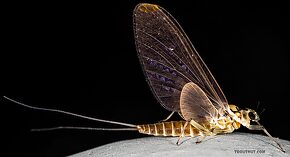 View 7 PicturesI was surprised by the olive cast on the body of this female Rhithrogena dun, which led me to mistake it for a western green drake (Drunella) in the field. I was pleasantly surprised to get a closer look and find something I hadn't collected yet. Its species ID is based on proximity to male spinner collected on the same trip, as well as physical similarity (size, tergite (
View 7 PicturesI was surprised by the olive cast on the body of this female Rhithrogena dun, which led me to mistake it for a western green drake (Drunella) in the field. I was pleasantly surprised to get a closer look and find something I hadn't collected yet. Its species ID is based on proximity to male spinner collected on the same trip, as well as physical similarity (size, tergite (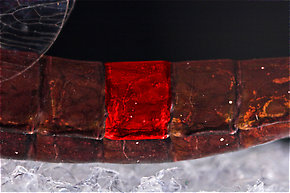 Tergite: The top (dorsal) part of a single segment on an insect's abdomen when it consists of a single chitinous plate (sclerite), or an individual sclerite if the segment has more than one.) coloration, dark streaks on the femora (
Tergite: The top (dorsal) part of a single segment on an insect's abdomen when it consists of a single chitinous plate (sclerite), or an individual sclerite if the segment has more than one.) coloration, dark streaks on the femora (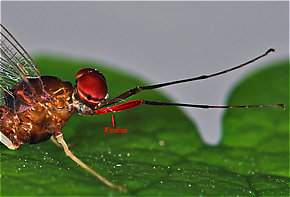 Femur: The main segment of an insect's leg close to the body, in between the tibia and the trochanter.)) to that specimen.
Femur: The main segment of an insect's leg close to the body, in between the tibia and the trochanter.)) to that specimen.
 View 7 PicturesI was surprised by the olive cast on the body of this female Rhithrogena dun, which led me to mistake it for a western green drake (Drunella) in the field. I was pleasantly surprised to get a closer look and find something I hadn't collected yet. Its species ID is based on proximity to male spinner collected on the same trip, as well as physical similarity (size, tergite (
View 7 PicturesI was surprised by the olive cast on the body of this female Rhithrogena dun, which led me to mistake it for a western green drake (Drunella) in the field. I was pleasantly surprised to get a closer look and find something I hadn't collected yet. Its species ID is based on proximity to male spinner collected on the same trip, as well as physical similarity (size, tergite (
One tergite of this Isonychia bicolor mayfly spinner is highlighted in red.

The femur of this Isonychia bicolor mayfly spinner is highlighted in red.
Collected July 4, 2020 from Mystery Creek #249 in Washington
Added to Troutnut.com by Troutnut on July 12, 2020
Added to Troutnut.com by Troutnut on July 12, 2020
Your Thoughts On Rhithrogena hageni:
Top 10 Fly Hatches
Top Gift Shop Designs
Eat mayflies.
Top Insect Specimens
Miscellaneous Sites
Troutnut.com is copyright © 2004-2024 Jason
Neuswanger (email Jason). See my FAQ for information about use of my images.
 privacy policy
privacy policy
